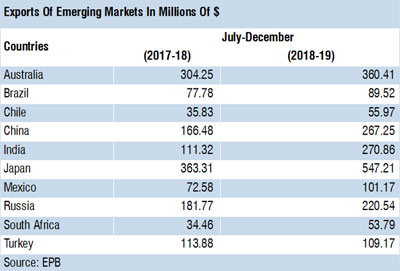
Bangladesh RMG Exporters Move To New Markets
Garment shipments to non-traditional markets grew by 41% year-on-year to US$ 2.07 billion in the first six months of the current fiscal year, 2018-19, compared to the same period of the previous year, which was US$ 1.46 billion.
The increase is being attributed to an incentive package and access of duty-free markets. Rather than traditional markets such as the USA, Canada, and Europe, others are considered non-traditional markets. Among them are Chile, China, Japan, India, Australia, Brazil, Mexico, Turkey, South Africa and Russia. They are the markets where Bangladeshi apparel exports are vastly growing.
Siddiqur Rahman, president of the Bangladesh Garment Manufacturers and Exporters Association (BGMEA) said that the government announced cash incentive to non-traditional markets back in 2010, which was 5% at that time.
Explaining the reason, Rahman said, previously, apparel makers did not want to go to those markets because of the difficulties involved and the time spent to enter a new market. A businessperson had to talk to a number of people, do their own research and gradually penetrate the market.
Secondly, when a manufacturer enters a new market, he or she needs to lower the product price below the average. For these two reasons, garment manufacturers were reluctant to explore the market.
But since the government provided cash incentive for a long period of time, garment exporters have started exploring the new destinations and markets. Another reason was that most of the non-traditional markets allow duty-free access to Bangladeshi apparel exporters, informed Siddiqur.
 In July-December of the 2018-19 financial year, Bangladesh earned US$ 267.26 million from China with growth of 60.54% from US$ 166.48 million in the same period of financial year 2017-18, according to the Export Promotion Bureau (EPB).
"China, the world's largest apparel supplier, has started importing products from us because the government of China has allowed duty-free access to over 5,000 Bangladeshi products. There are 40 to 50 crore people in China of the high-middle income group," said Siddiqur.
The inspection of Accord and Alliance has helped to remediate the factories and prompted factory owners to emphasise workplace safety, which eventually improved the country's image in front of foreign buyers. Eighty green garment factories are in operation that are completely LEED (Leadership in Energy and Environment Design) certified and another 300 are in the process of getting the certification.
Of the top 10 green garment factories in the world, seven are located in Bangladesh, said BGMEA president. In the July-December of the 2018-19 financial year, Bangladesh earned US$ 270.86 million from India, recording a growth of 143.30% from US$ 111.32 million in the same period of financial year 2017-18, according to Export Promotion Bureau (EPB).
Senior Vice President of the Bangladesh Garment Manufacturers and Exporters Association (BGMEA) Faruque Hassan cited a couple of reasons for this growth.
"Famous international retail brands such as Zara and H&M have established their business in India and we are their biggest supplier." "Another reason is that the Indian domestic market has grown and the number of fashion conscious consumers has increased. We import readymade garments (RMG), raw materials such as cotton and machinery from India. So, their export is also increasing. It is a win-win situation for both countries," he said.
In July-December of the 2018-19 financial year, Bangladesh earned US$ 267.26 million from China with growth of 60.54% from US$ 166.48 million in the same period of financial year 2017-18, according to the Export Promotion Bureau (EPB).
"China, the world's largest apparel supplier, has started importing products from us because the government of China has allowed duty-free access to over 5,000 Bangladeshi products. There are 40 to 50 crore people in China of the high-middle income group," said Siddiqur.
The inspection of Accord and Alliance has helped to remediate the factories and prompted factory owners to emphasise workplace safety, which eventually improved the country's image in front of foreign buyers. Eighty green garment factories are in operation that are completely LEED (Leadership in Energy and Environment Design) certified and another 300 are in the process of getting the certification.
Of the top 10 green garment factories in the world, seven are located in Bangladesh, said BGMEA president. In the July-December of the 2018-19 financial year, Bangladesh earned US$ 270.86 million from India, recording a growth of 143.30% from US$ 111.32 million in the same period of financial year 2017-18, according to Export Promotion Bureau (EPB).
Senior Vice President of the Bangladesh Garment Manufacturers and Exporters Association (BGMEA) Faruque Hassan cited a couple of reasons for this growth.
"Famous international retail brands such as Zara and H&M have established their business in India and we are their biggest supplier." "Another reason is that the Indian domestic market has grown and the number of fashion conscious consumers has increased. We import readymade garments (RMG), raw materials such as cotton and machinery from India. So, their export is also increasing. It is a win-win situation for both countries," he said.

Textile Excellence
If you wish to Subscribe to Textile Excellence Print Edition, kindly fill in the below form and we shall get back to you with details.












